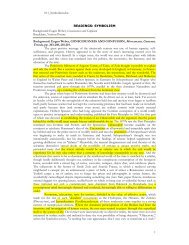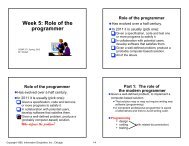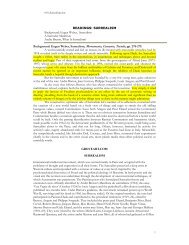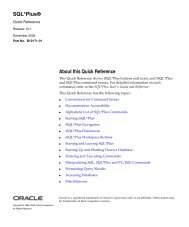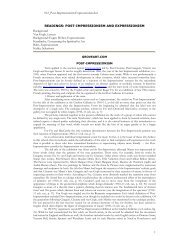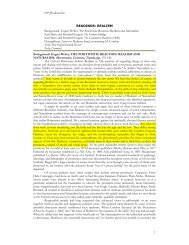A Closer Look at German Cost Accounting Methods - Seeing this ...
A Closer Look at German Cost Accounting Methods - Seeing this ...
A Closer Look at German Cost Accounting Methods - Seeing this ...
Create successful ePaper yourself
Turn your PDF publications into a flip-book with our unique Google optimized e-Paper software.
are the most widely used practices by firms indic<strong>at</strong>ingthey employ the GPK method (see Table 1). Here is alist of GPK practices in order of use by those firms:◆ Using contribution accounting (90%)◆ Analyzing variances by cost center (90%)◆ Using planned (standard) costs for most costingpurposes (77%)◆ Analyzing the consumption (total demand) foreach cost center (71%)◆ Having <strong>at</strong> least one output measure for each costcenter (64%)◆ Separ<strong>at</strong>ing fixed and proportional costs for eachcost center (62%)◆ Assigning indirect costs based on many cost centersand a network of cost assignments (57%)◆ Transferring costs from support cost centers toprimary cost centers while maintaining distinctionbetween fixed and proportional costs (57%)◆ Identifying and computing the cost of idle capacity(49%)These percentages suggest th<strong>at</strong> not all of the GPKpractices are used in each case. Many of the firms surveyedhave simplified and adapted GPK theory to theirown practical needs. For instance, some firms makeassumptions th<strong>at</strong> cost centers are either fixed or variable(i.e., no mixed cost centers). Thus, they do not separ<strong>at</strong>ethese cost types within cost centers.GPK A DOPTERSTo analyze the implement<strong>at</strong>ion of a costing system suchas GPK, two steps are necessary: (1) determining whohas tried GPK (i.e., “adopters”), and (2) identifyingwh<strong>at</strong> stage(s) of implement<strong>at</strong>ion constitutes usage (i.e.,“users”). In the case of GPK, some companies appearto use all the classic GPK practices, but others may onlyuse those they feel are appropri<strong>at</strong>e for their situ<strong>at</strong>ion.Furthermore, two firms may apply essentially the sameGPK practices, yet one might use the inform<strong>at</strong>ion on adaily basis while the other uses it only occasionally. InTable 1, we see th<strong>at</strong> firms identifying their costingmethod as GPK do not all use all of the GPK practices.We also see th<strong>at</strong> firms not calling their costing methodsGPK do use many of the associ<strong>at</strong>ed practices.To define GPK adopters, we conducted site visits tobetter understand why some firms th<strong>at</strong> appear to usemost or all of the GPK practices did not label their costingsystem as GPK. One reason is th<strong>at</strong> some firms associ<strong>at</strong>eGPK with the tool in SAP’s CO moduledeveloped in associ<strong>at</strong>ion with Plaut Consulting. Anotherreason is illustr<strong>at</strong>ed by AVU, a small utility companyin Gevelsberg, <strong>German</strong>y. Thorsten Sebo, head of Controlling,explained th<strong>at</strong> many people associ<strong>at</strong>e GPKwith Wolfgang Kilger, a leading <strong>German</strong> academic inthe field of cost accounting, and, therefore, consider itto be very theoretical. Kilger’s theory is th<strong>at</strong> variablecosts have to be strictly proportional with output, as inthe marginal cost of the last unit (i.e., the Grenzkosten ofGPK). Sebo said th<strong>at</strong> AVU’s system is better describedas Plankosten (planned costs) and is based on an approxim<strong>at</strong>emeasure of activity (e.g., an oper<strong>at</strong>ional measuresuch as hours). This approach is associ<strong>at</strong>ed with HansGeorg Plaut, the former automotive engineer whofounded Plaut Consulting, and is considered morepractical.Another reason is illustr<strong>at</strong>ed by Gebrüder BodeGmbH & Co. KG in Kassel, <strong>German</strong>y, which makesdoors for trains, buses, and cars. Although the companyis essentially doing all the GPK practices addressed in<strong>this</strong> study, its controller said Gebrüder Bode’s costingsystem is not GPK because almost all of its manufacturingis for specific customer orders. His comment was,“GPK cannot be used because we have many differentproduction methods and a lot of small-scale customerprojects.” He explained th<strong>at</strong> bus and train door ordersare generally for 300-500 units, and these may vary bycolor, lighting, fe<strong>at</strong>ures, etc. In his opinion, you cannotdo GPK in <strong>this</strong> situ<strong>at</strong>ion because you cannot planfuture production costs or set standards as you can for amore long-term product.For these reasons, we did not limit identific<strong>at</strong>ion ofGPK adoption to those firms th<strong>at</strong> labeled their cost systemas GPK. Instead, we asked respondents to identifythe implement<strong>at</strong>ion stage th<strong>at</strong> best described theircompany’s situ<strong>at</strong>ion regarding GPK. To define an“adopter” of GPK, we chose the stage, “Implementedthen abandoned” (Implementiert, dann jedoch aufgegeben)or higher. We chose <strong>this</strong> stage even though these firmsabandoned GPK because it means they did try it, butfor some reason (to be analyzed l<strong>at</strong>er in the “user”analysis) the implement<strong>at</strong>ion was not successful or sus-MANAGEMENT ACCOUNTING QUARTERLY 40 F ALL 2008, VOL. 10, NO. 1



